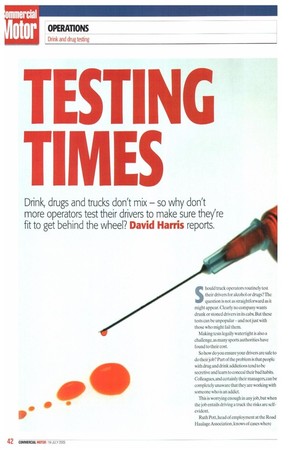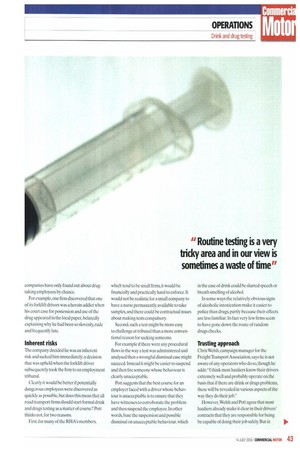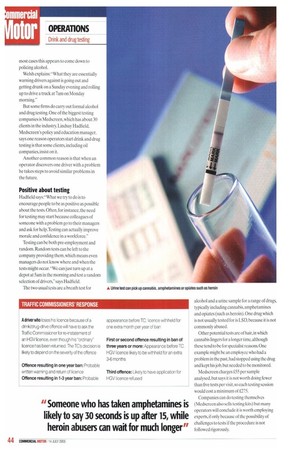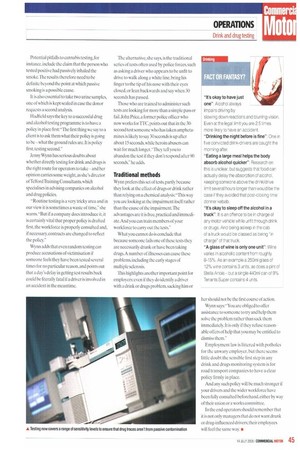ST NG
Page 42

Page 43

Page 44

Page 45

If you've noticed an error in this article please click here to report it so we can fix it.
MS
Drink, drugs and trucks don't mix — so why don't more operators test their drivers to make sure they're
fit to get behind the vvheel? David Harris reports.
Should truck operators routinely test their drivers for alcohol or drugs?The question is not as straightforward as it might appear. Clearly no company wants drunk or stoned drivers in its cabs. But these tests can be unpopular and not just with those who might fail them.
Making tests legally watertight is also a challenge, as many sports authorities have found to their cost.
So how do you ensure your drivers are safe to do their job? Part of the problem is that people with drug and drink addictions tend to be secretive and learn to conceal their bad habits. Colleagues, and certainly their managers can be completely unaware that they are working with someone who is an addict.
This is worrying enough in any job, but when the job entails driving a truck the risks are selfevident.
Ruth Pott, head of employment at the Road Haulage Association, knows of cases where companies have only found out about drugtaking employees by chance.
For example, one firm discovered that one of its forklift drivers was a heroin addict when his court case for possession and use of the drug appeared in the local paper, belatedly explaining why he had been so slovenly, rude and frequently late.
Inherent risks
The company decided he was an inherent risk and sacked him immediately; a decision that was upheld when the forklift driver subsequently took the firm to an employment tribunal.
Clearly it would be better if potentially dangerous employees were discovered as quickly as possible, but does this mean that all road transport firms should start formal drink and drugs testing as a matter of course? Pott thinks not, for two reasons.
First, for many of the RHA's members, which tend to be small firms, it would be financially and practically hard to enforce. It would not be realistic for a small company to have a nurse permanently available to take samples, and there could be contractual issues about making tests compulsory Second, such a test might be more easy to challenge at tribunal than a more conventional reason for sacking someone.
For example if there were any procedural flaws in the way a test was administered and analysed then a wrongful dismissal case might succeed. Instead it might be easier to suspend and then fire someone whose behaviour is clearly unacceptable.
Pott suggests that the best course for an employer faced with a driver whose behaviour is unacceptable is to ensure that they have witnesses to corroborate the problem and then suspend the employee. In other words, base the suspension and possible dismissal on unacceptable behaviour, which in the case of drink could be slurred speech or breath smelling of alcohol.
In some ways the relatively obvious signs of alcoholic intoxication make it easier to police than drugs, partly because their effects are less familiar. In fact very few firms seem to have gone down the route of random drugs checks.
Trusting approach
ChrisWelsh, campaign manager for the Freight Transport Association, says he is not aware of any operators who do so, though he adds: "I think most hauliers know their drivers extremely well and probably operate on the basis that if there are drink or drugs problems, these will be revealed in various aspects of the way they do their job."
However, Welsh and Pott agree that most hauliers already make it clear in their drivers' contracts that they are responsible for being be capable of doing their job safely. But in most cases this appears to come down to policing alcohol.
Welsh explains: "What they are essentially warning drivers against is going out and getting drunk on a Sunday evening and rolling up to drive a truck at 7am on Monday morning."
But some firms do carry out formal alcohol and drug testing. One of the biggest testing companies is Medscreen, which has about 30 clients in the industry. Lindsay Hadfield, Medscreen's policy and education manager, says one reason operators start drink and drug testing is that some clients, including oil com panies,insist on it.
Another common reason is that when an operator discovers one driver with a problem he takes steps to avoid similar problems in the future.
Positive about testing Hadfield says: What we try to do is to encourage people to be as positive as possible about the tests. Often, for instance, the need for testing may start because colleagues of someone with a problem go to their managers and ask for help.Testing can actually improve morale and confidence in a workforce."
Testing can be both pre-employment and random, Random tests can be left to the company providing them,which means even managers do not know where and when the tests might occur."We can just turn up at a depot at 5am in the morning and test a random selection of drivers," says Hadfield.
The two usual tests are a breath test for alcohol and a urine sample for a range of drugs, typically including cannabis, amphetamines and opiates (such as heroin). One drug which is not usually tested for is LSD, because it is not commonly abused.
Other potential tests are of hair, in which cannabis lingers for a longer time, although these tend to be for specialist reasons. One example might be an employee who had a problem in the past, had stopped using the drug and kept his job, but needed to be monitored.
Medscreen charges £55 per sample analysed, but says it is not worth doing fewer than five tests per visit, so each testing session would cost a minimum of 1275.
Companies can do testing themselves (Medscreen also sells testing kits) but many operators will conclude it is worth employing experts, if only because of the possibility of challenges to tests if the procedure is not followed rigorously. Potential pitfalls to cannabis testing, for instance, include the claim that the person who tested positive had passively inhaled the smoke:The results therefore need to be definite beyond the point at which passive smoking is a possible cause.
It is also essential to take two urine samples, one of which is kept sealed in case the donor requests a second analysis.
Hadfield says the key to a successful drug and alcohol testing programme is to have a policy in place first: "The first thing we say to a client is to ask them what their policy is going to he—what the ground rules are. It is policy first, testing second."
Jenny Wynn has serious doubts about whether directly testing for drink and drugs is the right route for operators to take and her opinion carries some weight, as she's director of Telford Training Consultants, which specialises in advising companies on alcohol and drug policies.
"Routine testing is a very tricky area and in our view it is sometimes a waste of time," she warns."But if a company does introduce it, it is certainly vital that proper policy is drafted first, the workforce is properly consulted and, if necessary, contracts are changed to reflect the policy."
Wynn adds that even random testing can produce accusations of victimisation if someone feels they have been tested several times for no particular reason, and points out that a day's delay in getting test results back could be literally fatal if a driver is involved in an accident in the meantime. The al ternative, she says, is the traditional series of tests often used by police forces, such as asking a driver who appears to be unfit to drive to walk along a white line, bring his finger to the tip of his nose with their eyes closed, or lean backwards and say when 30 seconds has passed.
Those who are trained to administer such tests are looking for more than a simple pass or fail. John Price, a former police officer who now works for 'ITC, points out that in the 30second test someone who has taken amphetamines is likely to say 30 seconds is up after about 15 seconds,while heroin abusers can wait for much longer. "They tell you to abandon the test if they don't respond after 90 seconds." he adds.
Traditional methods
\ in prefers this set of tests, partly because they look at the effect of drugs or drink rather than relying on a chemical analysis:"This way you are looking at the impairment itself rather than the cause of the impairment.The advantages are it is free, practical and immediate.Ancl you can train members of your workforce to carry out the tests."
What you cannot do is conclude that because someone fails one of these tests they are necessarily drunk or have been taking drugs.A number of illnesses can cause these problems. including the early stages of multiple sclerosis.
This highlights another important point for employers: even if they do identify a driver with a drink or drugs problem, sacking him or her should not be the first course of action.
Wynn says:"You are obliged to offer assistance to someone to try and help them solve the problem rather than sack them immediately. It is only if they refuse reasonable offers of help that you may be entitled to dismiss them."
Employment law is littered with potholes for the unwary employer, but there seems little doubt the sensible first step in any drink and drugs monitoring system is for road transport companies to have a clear policy firmly in place.
And any such policy will be much stronger if your drivers and the wider workforce have been fully consulted beforehand, either by way of their union or a works committee.
In the end operators should remember that it is not only managers that do not want drunk or drug-influenced drivers; their employees will feel the same way. •










































































































































































































